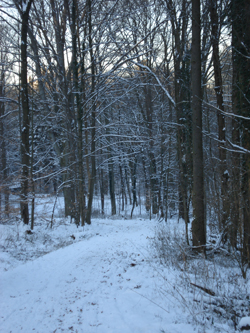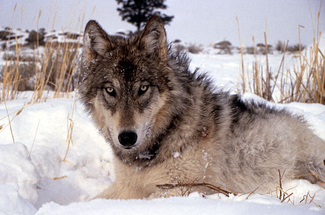During the climax of a plot, the reader is most engaged with what is happening in the story. The climax is the most exciting part of the plot, when the main conflict is resolved.

Source: Wald im Winter, Porsche 997 Carrerra, Wikimedia

Source: Yellowstone-wolf-17120-2, Doug Smith, Wikimedia
In the short story “The Interlopers” by Saki, the two male characters are not only neighbors but also enemies. They are trapped when a tree falls on them in the woods. Read the last scene from the story:
“I can see figures coming through the wood. They are following in the way I came down the hillside.”
Both men raised their voices in as loud a shout as they could muster.
“They hear us! They’ve stopped. Now they see us. They’re running down the hill towards us,” cried Ulrich.
“How many of them are there?” asked Georg.
“I can’t see distinctly,” said Ulrich; "nine or ten."
“Then they are yours,” said Georg; "I had only seven out with me."
“They are making all the speed they can, brave lads," said Ulrich gladly.
“Are they your men?” asked Georg. “Are they your men?" he repeated impatiently as Ulrich did not answer.
“No,” said Ulrich with a laugh, the idiotic chattering laugh of a man unstrung with hideous fear.
“Who are they?” asked Georg quickly, straining his eyes to see what the other would gladly not have seen.
“Wolves.”
In this short story, the climax is also the falling exposition and the resolution. In fact, the resolution is implicit, not stated in the story, but we are pretty sure that the men are going to be eaten by wolves. This scene is what makes the story so memorable. Without it, the story would not be nearly as intense. The horror and the irony make it enjoyable in the same way that a scary movie is enjoyable.
 In the next exercise, test what you have learned about climax. Using your notes, answer the questions below. When you’re finished, check your understanding to see some possible responses.
In the next exercise, test what you have learned about climax. Using your notes, answer the questions below. When you’re finished, check your understanding to see some possible responses. - How does a climactic scene relate to exposition and rising action? In other words, what does climax do in a plot?
- Usually, the climactic scene is the focal point of the entire plot. Why is climax so often the most exciting part of the plot?
Sample Response:
- Climax brings the story to a high point. What comes before the climax is there to explain the conflict. Exposition and rising action tell what the main problem in the story is or what trouble the main character faces. The climax shows how that conflict gets resolved.
- People like to see problems solved. If a story shows characters who are in a bind or who have a goal, the climax is satisfying because the trouble ends, or the goal gets accomplished. If the climax is negative, a lesson can be learned or the sadness (or horror) can be entertainingly ironic or fun in some other way.